You are on eastlansinginfo.org, ELi's old domain, which is now an archive of news (as of early April, 2020). If you are looking for the latest news, go to eastlansinginfo.news and update your bookmarks accordingly!
You are on eastlansinginfo.org, ELi's old domain, which is now an archive of news (as of early April, 2020). If you are looking for the latest news, go to eastlansinginfo.news and update your bookmarks accordingly!
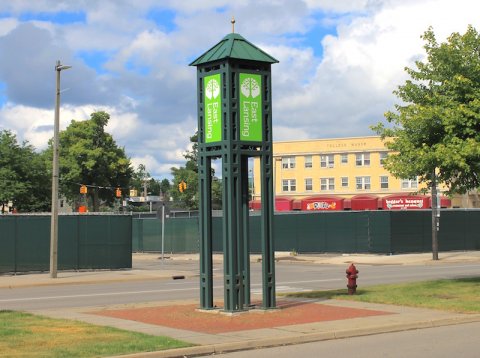
Above: The vacant lots along Grand River Avenue that would be the site of the first part of the DRW/Convexity project.
Details are now available on the proposed redevelopment deal being worked out between Chicago-based DRW/Convexity and East Lansing for the vacant parcels downtown. On Friday, members of East Lansing’s Downtown Development Authority (DDA) and the public received drafts of a tax financing plan and a Development Agreement for this project.
The draft financial and legal agreements became available just three days after City Council’s approval of the site plan and Special Use Permit for the construction of two large buildings, including a hotel, along Grand River Avenue between Abbot Road and Peoples Church, plus a moderate-income apartment building farther north on Evergreen Avenue (top-left in drawing below).
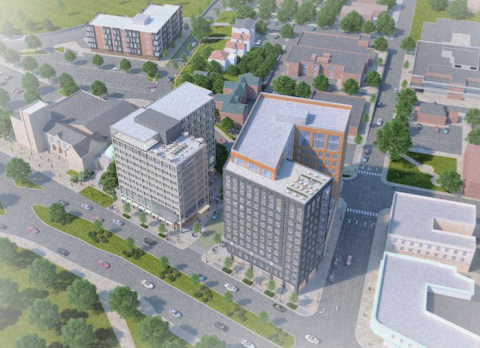
Draft documents show us what is being proposed in terms of the tax scheme, payments by the developer for purchase of publicly-owned land, incentives and penalties for various parts of the project, and more. The DDA and East Lansing Brownfield Redevelopment Authority (BRA) will discuss and possibly vote on the materials at the DDA meeting this Thursday, August 23.
The BRA, which has the same members as the DDA, acts on Tax Increment Financing (TIF) plans before they go to the City Council. The DDA as well as Council must sign a Development Agreement on this proposed project because it includes a portion of the land at 303 Abbot (at the southwest corner with Albert Avenue), which the DDA owns.
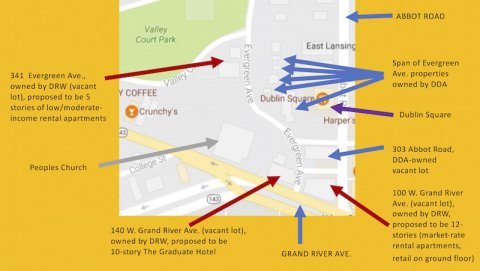
David Pierson, speaking on behalf of the developer DRW/Convexity, told a DDA committee last week that he hopes the Council will approve the Development Agreement at its September 18 meeting. Both a TIF plan and Development Agreement require three of five Council votes for passage. That means Council can act on them in the absence of two members who currently are on leave if the vote is unanimous.
A smaller, shorter tax increment financing plan compared to last time:
Under a tax increment financing (TIF) plan, the increase in property tax revenues that results from a redevelopment project is “captured” for a certain number of years and used to pay for eligible expenses. The taxing authorities continue to receive property taxes on the pre-redevelopment taxable value of the property, and the increased “increment” of property taxes generated by the redevelopment is used to reimburse whoever paid for the TIF-eligible expenses.
The proposed tax increment financing (TIF) plan in this case is for a total of $7.6 million (see it here), includng reimbursement to the developer of just under $6 million of eligible expenses. That $6 million includes $3.4 million for public infrastructure improvements that the City is asking the developer to build for it, including water and sewer system upgrades, realigning Albert Avenue on both sides of Abbot Road, and building new street surfaces and sidewalks. Another $1.1 million reimburses the developer for asbestos abatement and demolition of the vacant buildings (privately- and publicly-owned). The rest of the $6 million pays for environmental clean-up costs and interest on expenses, as explained below.
The remaining $1.6 million goes to pay Michigan's Brownfield Revolving Funds, East Lansing's BRA, the DDA, and taxes that go to East Lansing debt, ELPS debt, and the DDA.
This TIF plan would capture 100% of eligible new property taxes generated by the development for nine years, starting in 2020. If nine years isn’t enough to pay back what is in the plan, the tax capture can continue for more years, up to a limit of 30 years. The TIF plan captures new taxes only from the Grand River Avenue buildings, and doesn’t divert any of the taxes that would come from the new Evergreen Avenue building once it is complete.
The TIF does not provide funds up front to finance the project, since the TIF kicks in only after the project is done and the taxable value increases. Indeed, this TIF plan includes $1.1 million to reimburse the developer for putting up the funds (including for public infrastructure) at a 5% interest rate.
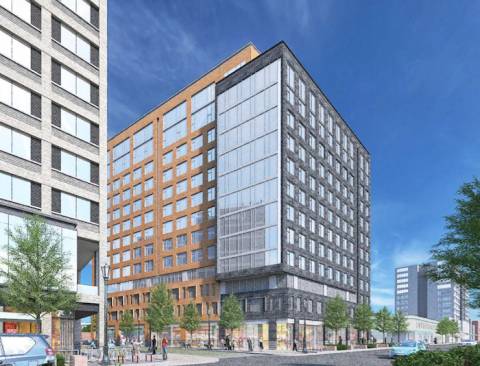
Above: The hotel (left) and "Building A" as shown looking from the southwest.
Some other cities deal with infrastructure improvements required by big redevelopments by paying for them with funds in the bank or bonding for them. The City of East Lansing is not in a good financial position to do either, so it typically asks developers to take on public infrastructure construction and be paid back out of TIF, with taxes reimbursing interest on the full amount of the TIF, even if it includes private development costs.
This draft TIF plan estimates that the current taxable value of the TIF-eligible properties is $839,500 and the total taxable value when development is completed in 2023 will be $15.5 million. TIF-eligible taxes on the difference between these amounts can be captured and used for reimbursements rather than flowing through to various taxing authorities.
Why East Lansing is considering this TIF plan:
Just to be clear, the taxes that would be captured would not all be coming otherwise to the City of East Lansing. Indeed, one reason some municipalities like East Lansing like to use Brownfield TIF financing is that taxes are captured from some other surrounding taxing authorities, focusing dollars in the locale of the municipality.
In this TIF plan, taxes expected to be captured over nine years include about $1.3 million from East Lansing City Operating funds, about $1 million from County operating funds, and much smaller amounts that would otherwise go to the City Solid Waste and Recycling, the East Lansing Public Library, Lansing Community College, East Lansing Public Schools – Building & Site, the Intermediate School District, the Capital Airport, and Capital Area Transportation Authority.
Pierson estimates that over the next thirty years, the City of East Lansing will see about $19 million in additional revenue from this project from real estate taxes, “personal property” taxes (which are really a tax on businesses), the City's new income tax, and utility connection charges. He frames it this way: East Lansing will be giving up about $1.3 million in taxes to obtain $19 million in new revenue over 30 years.
How this TIF compares to other recent TIFs:
This 9-year-long, $7.6 million TIF is considerably shorter and smaller than the TIF that was agreed to in April 2017 for the previous iteration of the DRW/Convexity project. That April 2017 TIF plan was for $29 million over 20 years.
The latest TIF plan is for a lesser amount largely because the development now being proposed is smaller; the total investment envisioned in 2017 was $154 million, whereas the current expected investment is $102 million. Much less public infrastructure work is also anticipated in this version, which is a significant component of eligible activities in these plans.
For an additional comparison, the City Center District TIF is for $58 million over 30 years. A significant part of that TIF plan is for building the public parking ramp on what used to be the Albert Avenue public parking lot and public infrastructure under Albert Avenue and resurfacing of that road.
What the Development Agreement tells us:
The draft Development Agreement for this proposal draws on the document that was agreed to by DRW/Convexity and the City in 2017. The Development Agreement covers topics such as project schedule, performance bonds, incentives, land transfer, easements, and staging areas. The discussion of the Development Agreement here is far from comprehensive.
A memo from DDA staff Tom Fehrenbach explains that, for the portion of 303 Abbot Road to be owned by the developer, the developer will pay the DDA $500,000. The draft Development Agreement also states that the developer will pay the City $337,000 for “all water and sewer tap and meter fees and capital connection charges,” for each of the three buildings in the project, totaling just over $1 million.
The Agreement lists conditions under which the developer could pull out. The deal requires approval of $10 million in Michigan Business Tax (MBT) Credits by state agencies. The failure of these agencies to approve the tax credit in the face of continued legal threat from the former owner-developer of this site, Scott Chappelle, derailed the project in the fall of 2017.
Below: The properties that Chappelle's business lost to foreclosure, before demolition.

At the DDA Committee meeting on August 16, DDA Chair Peter Dewan asked DRW’s attorney David Pierson about the status of negotiations with Chappelle. Pierson replied only that his client is still in litigation with Chappelle over Chappelle’s claim that DRW violated a confidentiality agreement. Reaching an agreement with Chappelle still appears to be pivotal to DRW obtaining the State tax credit and the deal going forward.
What else is in the proposed agreement:
The Development Agreement also spells out the staging area that may be used during the construction period, a topic of current interest because of the large scale of construction currently underway for the nearby Center City District project.
The staging area allowed for the DRW/Convexity project includes Parking Lot 4 (at the northwest corner and Albert Avenue and Abbot Road, next to Dublin Square), Albert Avenue and Evergreen Avenue (presumably referring to designated portions of these streets adjacent to the project), and 303 Abbot Road, with the possibility that other areas could be added.
Below, the "after" plan for the two main new buildings along Grand River Avenue:

The Development Agreement sets terms for when the developer must begin construction of the moderate-income apartment building on Evergreen Avenue. The developer plans to begin by building the two large Grand River Avenue-facing buildings and has asked to be able to wait up to 24 months after those buildings open before beginning construction of the third building. (The TIF plan depends only on the Grand River Avenue buildings.)
This 24-month period is included in the draft Development Agreement, despite Mayor Mark Meadows saying on August 16 that a delay of this duration was not acceptable to him. The third building is seen as crucial by City Council because it fulfills the condition of Ordinance 1384 that at least 25% of housing units in large downtown development projects be for senior housing, owner-occupied condos, or low/moderate-income housing.
Or else a park?
The draft Development Agreement does now provide a strong financial incentive for the developer to complete the third building (shown below) by August 2025 – namely loss of this property if it isn’t done on time.
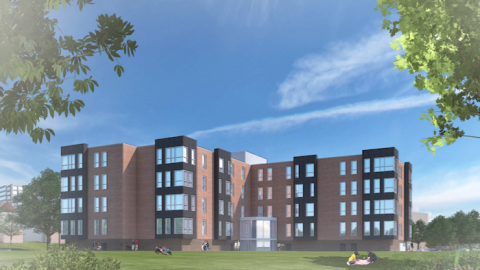
The Agreement states that, barring a list of unforeseen delays beyond the control of the developer, if this deadline is not met, the “Developer shall transfer fee title to the Building C Property to the City for use as a public park restricted to use of the property as a public park. Such transfer shall be deemed to satisfy any requirement of any City ordinance related to the types of housing that comprise the Project.”
In other words, the developer can give this property to the City and will not be considered to be out of compliance with Ordinance 1384 if it builds only the retail, market-rate apartments, and hotel on Grand River Avenue.
Another aspect of the draft Development Agreement that Meadows addressed on August 16 concerns labor contracts during construction. The draft agreement provides: “The public improvements as part of the Project shall be constructed either in accordance with the City’s prevailing wage policy or subject to a project labor agreement. The private improvements as part of the Project shall be constructed with a minimum of fifty percent (50%) of the contract value to be union trades. The Developer shall at all times make every reasonable effort to utilize residents of Michigan, and particularly from the Capital region….”
How you can weigh in:
Citizens wishing to weigh in on these agreements can attend and speak at the DDA and BRA meetings on Thursday (see schedule here) or can submit comments in writing to the City staff member who works with the DDA, Tom Fehrenbach.
eastlansinginfo.org © 2013-2020 East Lansing Info